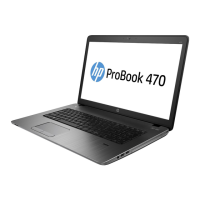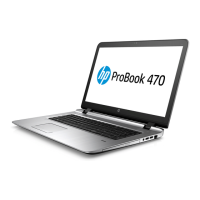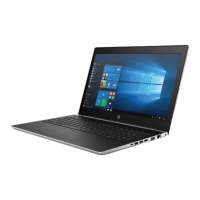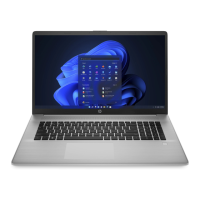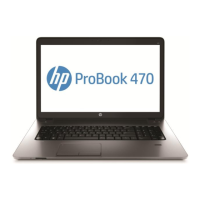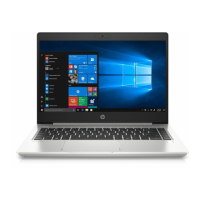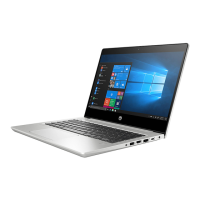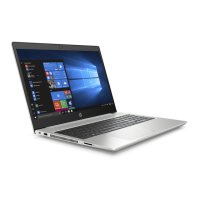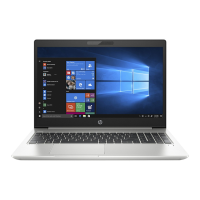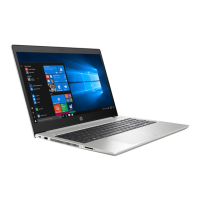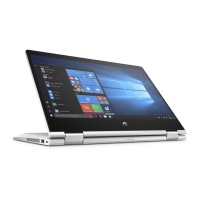Do you have a question about the HP 470 G7 and is the answer not in the manual?
Details precautions and methods to prevent damage from static electricity.
General procedures for replacing user-serviceable parts.
Steps to take before starting the disassembly process.
General procedures for authorized service provider parts.
Instructions for removing and replacing the bottom cover.
Step-by-step instructions for removing and replacing the computer's battery.
Guide for removing and installing RAM modules.
Procedures for removing and installing the computer's hard drive.
Instructions for removing and replacing the solid-state drive.
Detailed instructions for removing and replacing the system board.
Procedures for removing and replacing the entire display assembly.
Instructions for downloading and installing BIOS updates.
Guide on using the Windows-based diagnostic tool for hardware issues.
Instructions for using the UEFI-based diagnostic tool for hardware issues.
Methods for backing up personal data and creating system recovery media.
Options for restoring the computer from backups or recovery media.
Details precautions and methods to prevent damage from static electricity.
General procedures for replacing user-serviceable parts.
Steps to take before starting the disassembly process.
General procedures for authorized service provider parts.
Instructions for removing and replacing the bottom cover.
Step-by-step instructions for removing and replacing the computer's battery.
Guide for removing and installing RAM modules.
Procedures for removing and installing the computer's hard drive.
Instructions for removing and replacing the solid-state drive.
Detailed instructions for removing and replacing the system board.
Procedures for removing and replacing the entire display assembly.
Instructions for downloading and installing BIOS updates.
Guide on using the Windows-based diagnostic tool for hardware issues.
Instructions for using the UEFI-based diagnostic tool for hardware issues.
Methods for backing up personal data and creating system recovery media.
Options for restoring the computer from backups or recovery media.
| Form factor | Clamshell |
|---|---|
| Product type | Laptop |
| Product color | Gray |
| Country of origin | China |
| LED backlight | Yes |
| RGB color space | NTSC |
| Display diagonal | 17.3 \ |
| Anti-glare screen | Always gives an optimal view, even in direct sunlight. |
| Display brightness | 300 cd/m² |
| Native aspect ratio | 16:9 |
| NTSC coverage (typical) | 72 % |
| Display diagonal (metric) | 43.9 cm |
| Memory slots | 1x SO-DIMM |
| Internal memory | 8 GB |
| Memory clock speed | 2666 MHz |
| Memory form factor | SO-DIMM |
| Internal memory type | DDR4-SDRAM |
| Maximum internal memory | - GB |
| Memory layout (slots x size) | 1 x 8 GB |
| Number of built-in speakers | 2 |
| Front camera HD type | HD |
| Front camera signal format | 720p |
| SSD capacity | The Solid State Drive's storage capacity in Gigabytes. |
| SSD interface | PCI Express, NVMe |
| Storage media | SSD |
| Total storage capacity | 256 GB |
| Number of SSDs installed | 1 |
| MIMO type | Multi User MIMO |
| Antenna type | 2x2 |
| Bluetooth version | 5.0 |
| Top Wi-Fi standard | Wi-Fi 6 (802.11ax) |
| WLAN controller model | Intel Wi-Fi 6 AX201 |
| WLAN controller manufacturer | Intel |
| HDMI version | 1.4 |
| USB 2.0 ports quantity | USB 2.0 ports have a data transmission speed of 480 Mbps, and are backwards compatible with USB 1.1 ports. You can connect all kinds of peripheral devices to them. |
| Thunderbolt 3 ports quantity | 0 |
| Pointing device | Touchpad |
| Sustainability certificates | ENERGY STAR |
| AC adapter power | 65 W |
| Cable lock slot type | Kensington |
| Battery capacity | 41 Wh |
| Number of battery cells | 3 |
| HP segment | Business |
| HP speaker type | HP Dual Speakers |
| Tjunction | 100 °C |
| Processor cache | 8 MB |
| Processor cores | 4 |
| Processor model | i7-10510U |
| System bus rate | 4 GT/s |
| Processor family | Intel® Core™ i7 |
| Processor socket | BGA 1528 |
| Processor threads | 8 |
| Processor codename | Comet Lake |
| Configurable TDP-up | 25 W |
| Processor frequency | 1.8 GHz |
| Processor cache type | L3 |
| Configurable TDP-down | 10 W |
| Processor lithography | 14 nm |
| PCI Express slots version | 3.0 |
| Processor boost frequency | 4.9 GHz |
| Processor operating modes | 64-bit |
| PCI Express configurations | 1x4, 2x2, 1x2+2x1, 4x1 |
| Thermal Design Power (TDP) | 15 W |
| Configurable TDP-up frequency | 2.3 GHz |
| Configurable TDP-down frequency | 0.8 GHz |
| Maximum number of PCI Express lanes | 16 |
| Discrete GPU manufacturer | AMD |
| Number of execution units | 24 |
| On-board graphics card ID | 0x9B41 |
| Discrete graphics card model | AMD Radeon 530 |
| On-board graphics card model | Intel® UHD Graphics |
| Discrete graphics card memory | 2 GB |
| Discrete graphics memory type | GDDR5 |
| Maximum on-board graphics card memory | 32 GB |
| On-board graphics card OpenGL version | 4.5 |
| On-board graphics card base frequency | 300 MHz |
| On-board graphics card DirectX version | 12.0 |
| On-board graphics card dynamic frequency (max) | 1150 MHz |
| Processor ARK ID | 196449 |
| Processor package size | 46 x 24 mm |
| Supported instruction sets | SSE4.1, SSE4.2, AVX 2.0 |
| Depth | 272 mm |
|---|---|
| Width | 414.8 mm |
| Height | 24.5 mm |
| Weight | 2360 g |
